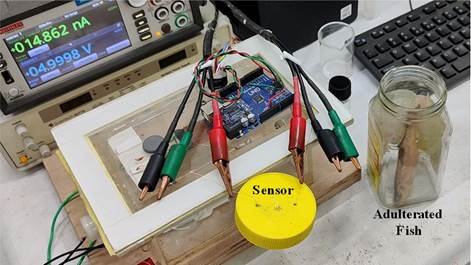Tuesday, 2 December 2025

The sensor has been tested for adulterated fish at lab scale as well on fish available in the fish markets of the Guwahati region.
Nanomaterials and Nanoelectronics Laboratory, headed by Dr Hemen Kr. Kalita, Assistant Professor, Department of Physics, Guwahati University, Assam has developed a cost-effective formalin sensor using tin oxide-reduced graphene oxide composite that can effectively detect the presence of formalin in adulterated fishes.
A new low-cost sensor made of metal oxide nanoparticles–reduced graphene oxide composite can detect formalin adulteration in fishes at room temperature in a non-invasive way. The sensor shows long-term stability with a low detection limit.
Food adulteration is the practice of adding illegal or harmful substances to food to make it appear more appealing or to increase its shelf life. Formaldehyde is a colourless, pungent gas that is used in a variety of industrial processes, including as a preservative in some foods, commonly in fish in developing countries. However, the use of formaldehyde in food is illegal in many countries, as it is a known carcinogen.
Commercial formalin sensors for fish are primarily electrochemical-based or colorimetric-based. Electrochemical sensors are extensively used but are expensive. On the other hand, calorimetric sensors are less expensive. But both methods are invasive. Moreover, low-level detection and selective detection are two major issues with these sensors. The development of 2D materials-based gas sensors has created a new avenue of effective detection of toxic vapours at room temperature. These sensors have the potential to detect the formalin evaporated from adulterated food products.
Graphene oxide (GO), the oxidized form of graphene, exhibits high solution processability and ease of chemical modification with other materials such as metals, metal oxides, or polymers. However, the low electrical conductivity of GO posed a challenge and the scientists overcame this by developing the tin oxide-reduced graphene oxide composite (rGO- SnO2).
While reduced graphene oxide (rGO) has been used to detect various toxic gases and VOCs, tin oxide (SnO2) has been extensively investigated for formaldehyde detection in pristine form and by incorporating it with various compounds, including graphene, due to its high stability and high sensitivity toward low concentrations of formaldehyde.
The researchers synthesised graphene oxide (GO) through a process called the wet chemical approach and tin oxide-reduced graphene oxide composite (rGO- SnO2) was synthesised by hydrothermal route followed by calcination of the obtained product. They found that the sensor made of tin oxide decorated reduced graphene oxide effectively sensed formaldehyde vapour at room temperature.